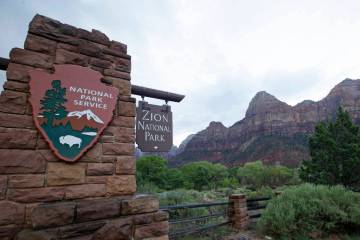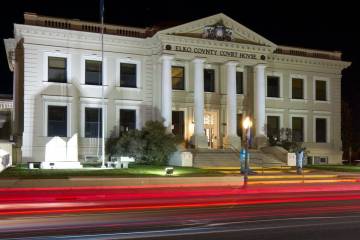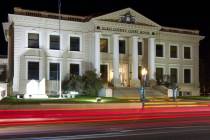SPLITSVILLE, U.S.A.
CARSON CITY -- The ease with which Gov. Jim Gibbons sealed his divorce from public view is a legacy of Reno's race with Hot Springs, Ark., nearly 80 years ago, to become the "Divorce Capital of America."
Gibbons, 63, filed for divorce May 2 from his wife of 22 years, former Assemblywoman Dawn Gibbons, 54.
Three days later, District Judge Bill Maddox agreed to seal the divorce records and hold the proceedings in private.
Maddox acted on a law that allows one party to a divorce action to have the case sealed.
State Sen. Harry Heidtman introduced the law during the 1931 Legislature as a companion to another law passed that session giving Nevada the shortest waiting period for a divorce in the country: six weeks.
Nevada had operated under a 90-day residency law since 1927.
The two laws gave Reno the upper hand in its rivalry with Hot Springs to attract divorce-minded tourists.
"Hot Springs was a lot like Reno," State Archivist Guy Rocha said. "Al Capone and mobsters went there. It had gaming. So did Reno. In those days, the law looked the other way on gaming. They were open cities."
Most people seeking a divorce at the time preferred to travel to Hot Springs, rather than Reno. Nevada was a little-regarded state with only 91,000 residents.
But the divorce-friendly statutes worked. Hot Springs lost the divorce-capital battle.
"It wasn't a moral issue for Nevada; it was an economic issue," said Phil Earl, a retired state historian. "They wanted to find a way to attract people here to spend money."
In the 1930s, the rich would shuffle off to Reno while "he still had dough," as a popular song of the day described it. Popular culture soon was filled with references to wealthy women heading of to Reno for "the cure."
Divorce seekers during the Depression tended to be wealthy women who could afford $250 to hire a Reno divorce lawyer and cover the $1,500 cost of a six-week stay at a dude ranch or a downtown hotel. Some Reno residents rented out space in their homes to people seeking divorces and accompanied them to court to vouch that they had lived the required six weeks in the state.
Exiting the Washoe County Courthouse after their private, five-minute hearings, some new divorcées would pull off their wedding rings and toss them into the nearby Truckee River.
The small, desert town of Las Vegas didn't begin to make inroads on Reno's divorce revenue until 1939. That's when Maria Gable, who was usually called Ria, set up residence there to shed her husband, actor Clark Gable.
Clark Gable had left Ria Gable, who was 17 years his senior, three years earlier for actress Carole Lombard, who had divorced her husband, actor William Powell, in 1933 in Carson City.
A string of celebrities would follow, seeking divorces in Southern Nevada and Northern Nevada where any salacious details would be kept under wraps.
Frank Sinatra chose Las Vegas for his first divorce in 1951, when he split with his first wife Nancy to marry actress Ava Gardner.
In 1956, playwright Arthur Miller spent six weeks at a ranch near Pyramid Lake, awaiting a divorce from his first wife Mary. Eighteen days later, Miller married actress Marilyn Monroe.
Inspired by the cowboys he met while in Nevada, Miller would write the screenplay for "The Misfits" -- the term for cowboys who caught horses and sold them for meat -- which starred Monroe and Gable.
The movie would be the last for both stars.
In terms of national impact, however, the most significant example of a celebrity using Nevada's secrecy-in-divorce law came in 1962 when Mary "Tod" Rockefeller divorced her husband, New York Gov. Nelson Rockefeller, who was having an affair with a staff member.
The national press closely followed the split, but all they received was a couple of curt, nonanswers from Mary Rockefeller's sons as she left the Washoe County Courthouse.
The divorce and Nelson Rockefeller's quick remarriage to "Happy" Rockefeller hurt his political fortunes. He had been the favorite to win the 1964 Republican presidential nomination, but Arizona Sen. Barry Goldwater instead became the nominee.
Dawn Gibbons' lawyer, Cal Dunlap, filed a motion on May 28 seeking to have the Gibbonses' divorce conducted in public and asking that Nevada's divorce secrecy law be declared unconstitutional when it is applied to public officials.
"There is no greater public property right in court proceedings or need for public scrutiny of judicial proceedings than when the Plaintiff holds one of the highest offices in a state, in this case, the Governor of the State of Nevada, and then seeks to bar the press and the public from the contents of the Court and from Court Proceedings," Dunlap stated in his motion to open the case.
Dunlap charged that the real reason the governor wants a divorce is because he has been involved with another woman, later identified as Kathy Karrasch, the estranged wife of Reno podiatrist C. Craig Karrasch.
The governor has denied having an affair with Kathy Karrasch, saying the relationship is a 15-year platonic friendship.
The law being challenged by Dawn Gibbons contains virtually the same language as the one state Sen. Heidtman drafted in 1931.
Both the old and current laws say that "upon demand of either party" a court "shall" seal divorce records and hold the divorce trial behind closed doors.
The Reno Evening Gazette, in its March 6, 1931, edition, reported that Heidtman figured preventing "publication of any details of a divorce action excepting the names of the parties' involved" would make Nevada even more attractive to divorce seekers.
There was a time during the 1931 session when legislators even talked about making Nevada a mail-order divorce state, according to Earl.
That suggestion was quickly dismissed, however, after someone pointed out that such an action would eliminate any incentive to visit Nevada and spend money.
The signing of Nevada's quickie divorce law, on March 19, 1931, has always been overshadowed by another bill Gov. Fred Balzar signed that day, one introduced by cowboy Assemblyman Phil Tobin of Winnemucca.
Tobin's bill legalized gambling and would eventually turn Las Vegas into one of the most famous cities in the world.
But the old cowboy would die, in 1976, virtually penniless, having spent much of his life living in bunkhouses as he worked out of isolated ranches in Northern Nevada.
Contact Capital Bureau Chief Ed Vogel at evogel@reviewjournal.com or 775-687-3901.






























